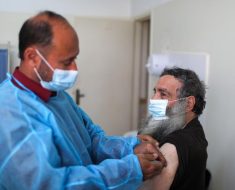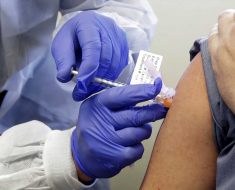Whitney Sandoval’s two children begin kindergarten and first grade this week in Wichita, KS. While she’ll be sending her kids with masks, the school district hasn’t mandated them.
Her children are too young to be vaccinated, but the community’s COVID-19 transmission rates have been rising all summer and are similar to last winter’s.
“Sending them back makes me feel like I’m just guaranteeing they’ll get exposed,” she says, “which is extra defeating after successfully being so careful for over a year.”
But having lived through all that time at home with her small children, Sandoval and her husband are too spent — emotionally and financially — to consider pulling them out.
If that feels familiar, you may live in one of the 70% of U.S. counties where transmission is so high, the CDC recommends everyone wear masks indoors. (They’ve already recommended staff and students ages 2 and up be masked at school, regardless of vaccination status.) But because these are only recommendations, at this point, each individual school district can decide their policy. Unless, of course, you live in one of the handful of states, including Arizona, Georgia, and Texas, whose governors have banned mask mandates completely.
The Delta Variant
Until the Delta variant swept the world, most experts believed children were less susceptible to this coronavirus. Now, though, pediatric COVID cases are rising sharply. The American Academy of Pediatrics (AAP) says in the last 2 weeks of July, the number of cases in kids leapt from 39,000 to 72,000. And while it’s still too new to know for sure, some experts are seeing signs that Delta hits kids harder than the original virus, with more children being hospitalized. The CDC is collecting evidence to analyze.
Summer camp-related outbreaks have highlighted the new challenges of Delta.
“It shows kids aren’t immune to Delta, they don’t have a superpower,” says Katelyn Jetelina, PhD, an epidemiologist with UTHealth School of Public Health in Dallas. She writes the popular newsletter Your Local Epidemiologist. “Also, really importantly, we’ve seen that kids can take the Delta virus back home with them and infect other household members.”
Add in the fact that people infected with the Delta variant may carry 1,000 times as much of the virus as earlier versions, and the thought of children bringing it home from school becomes even more alarming. In several locations, including schools in Arizona, Georgia, and Mississippi, where the school year has already begun and masks are optional, new COVID-19 outbreaks have forced temporary closures or quarantines. (Learn more about the Delta variant and kids here.)
COVID, Kids, and School
We know how to protect children from COVID-19 at school, says Yvonne Maldonado, MD, chair of the AAP committee on infectious diseases.
“If you look at the data, when you have kids going back to school appropriately — that is, with masks and distancing, if possible — and you have vaccinated adults who work in the school, you are going to see almost no transmissions happening in that situation,” she says.
Numerous studies based on the last school year found that when districts used some combination of mitigation measures, including universal mask-wearing, distancing, good ventilation, and hand-washing, transmission rates within the schools were often lower than in the local communities.
There’s no reason to think those same measures won’t protect children this time around, Maldonado says. Each of them is included in the AAP’s guidance for schools, published in late June.
And just as we learned what works from the last school year, we also see what doesn’t, says Beth Pathak, PhD, an epidemiologist and a founder of the COVKID Project, which tracks pediatric cases in the U.S.
“Things like Plexiglas dividers, wiping everything down, even sitting 6 feet apart inside a classroom really doesn’t do much,” she says. Without proper ventilation, “just from breathing, the virus will spread throughout the room. The main things that help with COVID are air filtration, ventilation, and masking.”
Twelve of the nation’s 20 largest school districts have announced mask mandates for students and staff, according to CNN. The remaining eight are in Florida and Texas, which have rejected mandates.
The Vaccine Question
One key way to protect children under 12, who are not eligible for the COVID-19 vaccines, is for anyone around them who is eligible to be vaccinated, says Maldonado.
Under the FDA’s emergency use authorization, the vaccines have been proven safe and effective at preventing severe cases, hospitalizations, and deaths, but few school districts have gone so far as to mandate vaccinations for adults. New York City will require all public school staff to either be vaccinated or get tested weekly. Los Angeles public schools will be testing staff and students weekly, but there will be no vaccine mandate.
Education Secretary Miguel Cardona says 90% of U.S. teachers are already vaccinated. And the head of one of the nation’s top teachers unions on Sunday called for mandatory vaccinations for teachers.
“The circumstances have changed,” Randi Weingarten, president of the American Federation of Teachers, told NBC News’s Meet the Press. “It weighs really heavily on me that kids under 12 can’t get vaccinated.”
But the National Education Association, the nation’s largest teachers union, supports local school districts deciding whether to require vaccinations.
As of Aug. 5, nearly 8 million 12- to 17-year-olds in the U.S. were fully vaccinated, which means they received their second dose at least 2 weeks ago. It may sound like a large number, but it’s less than one-third of the country’s 25 million kids who are old enough to receive the vaccine. With school starting in many areas of the country, most older students won’t be vaccinated.
“If all policy was based on science, it makes sense to require vaccinations,” says Jetelina. “We have required vaccinations for all types of other diseases in schools, and it works really well. We have a lot of follow-up data now, a lot of safety data. It may be time to implement the stick rather than the carrot. We need to get out of this somehow.”
But especially in the current political climate, vaccine mandates aren’t so simple. According to recent data, 58% of Americans who say they definitely won’t get the vaccine are Republicans, and every state that has banned mask or vaccine mandates is led by members of the GOP.
“I’ve been working with vaccines for a long time, and people don’t like to be told what to do,” says Maldonado. “But if it means shutting down society, there has to be a line. If it’s personal preference — not medical exemptions — versus someone’s risk of being hospitalized and dying of a preventable disease, it’s pretty clear where we need to weigh in.”
The FDA is aiming to complete the final approval process for the Pfizer vaccine by early September, according to The New York Times. That could open the door to more vaccine mandates. And emergency use authorization for younger children is on the horizon.
“I’m working with the vaccine trials now, and they’re going incredibly well,” says Maldonado. “We’re really hopeful that we’ll be able to get emergency use authorization before the end of the year for 5- to 12-year-olds, and potentially for under-5s next year.”
Going Back to School
Even as our understanding of the virus and the Delta variant seems to change daily, the beginning of the school year looms. Here’s what you can do to protect your children:
-
Regardless of whether your school district has a mask mandate, insist your children wear masks. “If we have kids going back without masks, we’re going to see a huge blowup in cases,” says Pathak. You, too, should wear a mask indoors when you leave home.
-
Get any child who’s over 12 years old vaccinated as soon as possible.
-
If you’re not satisfied with your local school board’s approach, Jetelina published a guide to advocating for your children’s safety in her newsletter.
-
Live in an area with minimal safety measures in place? You’ll have to do a little detective work before deciding on a course of action. Jetelina recommends looking at county-level COVID data: What’s the level of transmission? Is the case number going up or down? What’s the test positivity rate? Once you’ve gathered that information, you’ll need to make some decisions. “Everyone has their own risk tolerance threshold,” she says. “It’s a conversation to have as a family unit as well as with their pediatrician. There are lots of benefits to in-school learning — whether those benefits outweigh the risks has to be a personal decision for the family.”
-
Remember the idea of COVID pods, where like-minded families would socialize only with each other? Maldonado suggests forming new ones with families where everyone eligible is vaccinated, who are masking and avoiding high-risk behaviors. “Kids need to have their own friends, to have social events,” she says.
-
The CDC has created an info page for parents, with guidance about best practices and what to expect.
-
Remember that what we know about the virus is being updated constantly, so guidelines and recommendations may still change. “I’m trying to be OK with everything, even though I super am not OK with it,” says Sandoval.
Source: Read Full Article





